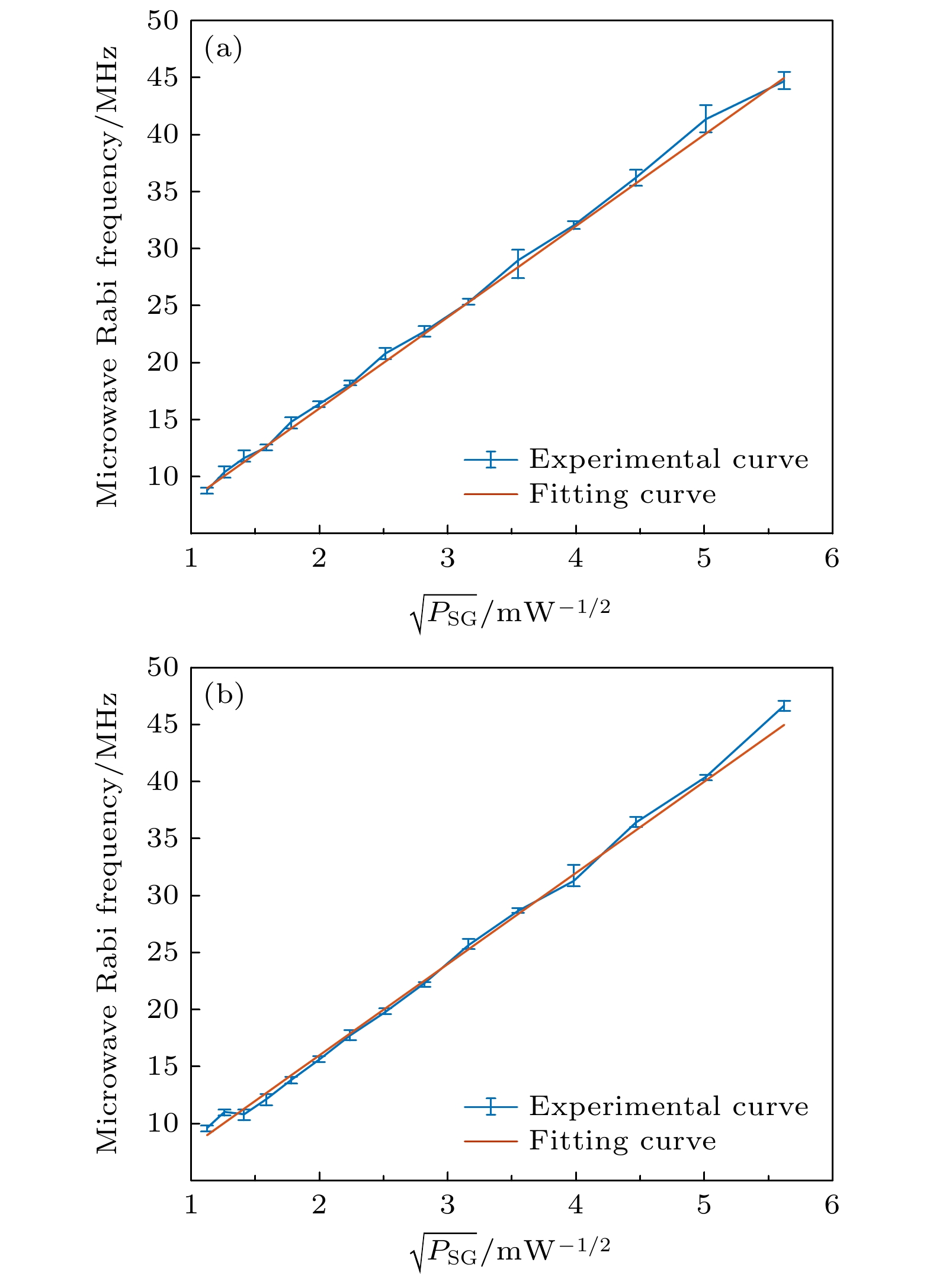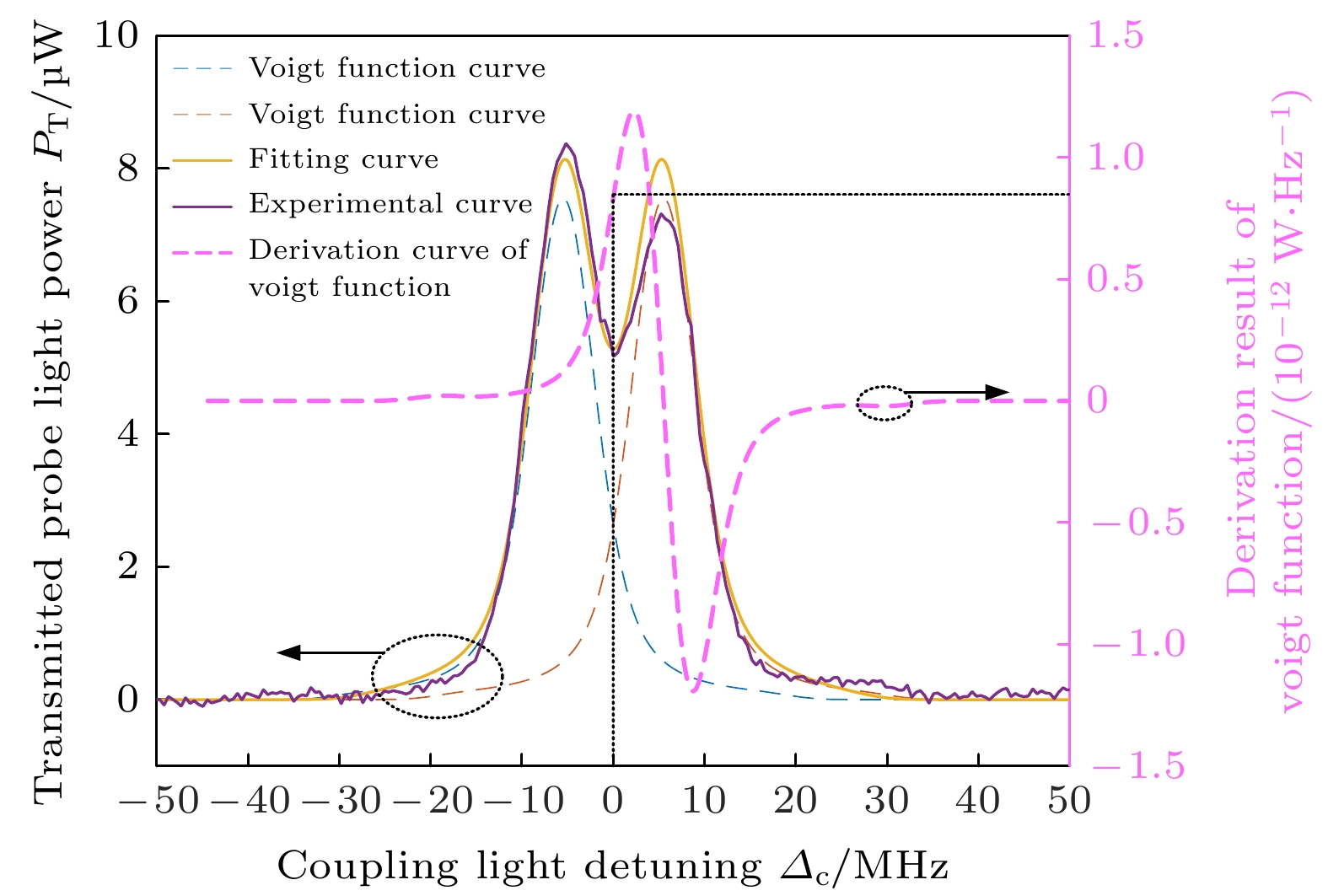-
里德堡原子利用其电磁诱导透明效应可以实时响应微弱的微波电场信号, 实现空间微波电场信号的下变频, 作为超外差接收机使用. 里德堡原子超外差接收机是由里德堡原子、光电探测器以及电子信息处理模块等组成的新体制接收系统. 目前, 国内外学者对里德堡原子超外差接收技术的物理响应机理进行了深入研究, 然而在缺乏完整的接收链路分析模型的指导下, 不利于系统性能优化. 本文从里德堡原子响应微波电场的物理机理出发, 引入内禀增益系数的概念, 建立并实验验证了里德堡原子超外差接收机的接收链路模型, 简要讨论了内禀增益系数对系统灵敏度和响应特性的影响, 为里德堡原子超外差接收系统性能优化提供理论指导. 最后对里德堡原子接收链路和电子学接收链路的灵敏度性能进行了讨论和对比.Rydberg atom can respond to weak microwave electric field signal in real-time by using its electromagnetically induced transparency effect to realize down conversion of space microwave electric field signal, which can be used as a superheterodyne receiver. The Rydberg atom superheterodyne receiver is a new receiving system composed of Rydberg atoms, photodetectors, and electronic information processing modules. Presently, the physical response mechanism of Rydberg atomic superheterodyne receiving technology is studied in depth. However, no complete receiving link analysis model has been established, which is not conducive to optimizing its system performance. Based on the physical mechanism of the Rydberg atom responding to the microwave electric field, this paper introduces the concept of intrinsic expansion coefficient, establishes and experimentally verifies the receiving link model of the Rydberg atom superheterodyne receiver, and briefly discusses the influence of the intrinsic expansion coefficient on the system sensitivity and response characteristics, thereby providing the theoretical guidance for optimizing the performance of the Rydberg atom superheterodyne receiving system. In the end, the Rydberg atomic and the electronic receiving links' sensitivity performance is discussed and compared.
-
Keywords:
- Rydberg atoms /
- intrinsic expansion coefficient /
- receiving link /
- microwave electric field
[1] Anderson D A, Sapiro R E, Raithel G 2021 IEEE Trans. Antennas Propag. 69 2455
 Google Scholar
Google Scholar
[2] Holloway C L, Simons M T, Haddab A H, Gordon J A, Anderson D A, Raithel G, Voran S D 2021 IEEE Antennas Propag. Mag. 63 63
 Google Scholar
Google Scholar
[3] Song Z F, Liu H P, Liu X C, Zhang W F, Zou H Y, Zhang J, Qu J F 2019 Opt. Express 27 8848
 Google Scholar
Google Scholar
[4] Meyer D H, Cox K C, Fatemi F K, Kunz P D 2018 Appl. Phys. Lett. 112 211108
 Google Scholar
Google Scholar
[5] Zou H Y, Song Z F, Mu H H, Feng Z G, Qu J F, Wang Q L 2020 Appl. Sci. -Basel 10 1346
 Google Scholar
Google Scholar
[6] Deb A B, Kjaergaard N 2018 Appl. Phys. Lett. 112 211106
 Google Scholar
Google Scholar
[7] Holloway C L, Simons M T, Gordon J A, Novotny, D 2019 IEEE Antennas Wirel. Propag. Lett. 18 1853
 Google Scholar
Google Scholar
[8] Simons M T, Haddab A H, Gordon J A, Novotny D, Holloway C L 2019 IEEE Access 7 164975
 Google Scholar
Google Scholar
[9] Meyer D H, Kunz P D, Cox K C 2021 Phys. Rev. Appl. 15 014047
 Google Scholar
Google Scholar
[10] Robinson A K, Prajapati N, Senic D, Simons M T, Holloway C L 2021 Appl. Phys. Lett. 118 114001
 Google Scholar
Google Scholar
[11] Mao R Q, Lin Y, Yang K, An Q, Fu Y Q 2018 IEEE Antennas Wirel. Propag. Lett. Early Access
[12] Holloway C L, Gordon J A, Jefferts S, Schwarzkopf A, Anderson D A, Miller S A, Thaicharoen N, Raithel G 2014 IEEE Trans. Antennas Propag. 62 6169
 Google Scholar
Google Scholar
[13] Thaicharoen N, Moore K R, Anderson D A, Powel R C, Peterson E, Raithel G 2019 Phys. Rev. A 100 063427
 Google Scholar
Google Scholar
[14] Holloway C L, Gordon J A, Schwarzkopf A, Anderson D A, Miller S A, Thaicharoen N, Raithel G 2014 Appl. Phys. Lett. 104 244102
 Google Scholar
Google Scholar
[15] Kumar S, Fan H, Kübler H, Jahangiri A J, Shaffer J P 2017 Opt. Express 25 8625
 Google Scholar
Google Scholar
[16] 廖开宇, 涂海涛, 张新定, 颜辉, 朱诗亮 2021 中国科学: 物理学 力学 天文学 51 14
Liao K Y, Tu H T, Zhang X D, Yan H, Zhu S L 2021 Sci. Chin. -Phys. Mech. Astron. 51 14
[17] Liao K Y, Tu H T, Yang S Z, Chen C J, Liu X H, Liang J, Zhang X D, Yan H, Zhu S L 2020 Phys. Rev. A 101 053432
 Google Scholar
Google Scholar
[18] Jing M, Hu Y, Ma J, Zhang H, Zhang L J, Xiao L T, Jia S T. 2020 Nat. Phys. 16 911
 Google Scholar
Google Scholar
[19] Cai M H, Xu Z S, You S H, Liu H P 2022 Photonics 9 250
 Google Scholar
Google Scholar
[20] Sedlacek J. A, Schwettmann A, Kübler H, Shaffer 2013 Phys. Rev. Lett. 111 063001
 Google Scholar
Google Scholar
[21] Bussey L W, Winterburn A, Menchetti M, Burton F, Whitley T 2021 J. Lightwave Technol. 39 7813
 Google Scholar
Google Scholar
[22] Simons M T, Haddab A H, Gordon J A, Holloway C L 2019 Appl. Phys. Lett. 114 114101
 Google Scholar
Google Scholar
[23] Anderson D A, Paradis E G, Raithel G 2018 Appl. Phys. Lett. 113 073501
 Google Scholar
Google Scholar
[24] Sapiro R E, Raithel G A, Anderson D 2020 J. Phys. B:At. , Mol. Opt. Phys. 53 094003
 Google Scholar
Google Scholar
[25] Meyer D H, O'Brien C, Fahey D P, Cox K C, Kunz P D 2021 Phys. Rev. A 104 043103
 Google Scholar
Google Scholar
[26] Fancher C T, Scherer D R, John MCS, Schmittbergermarlow B 2021 IEEE Trans. Quantum Eng. 2 3501313
 Google Scholar
Google Scholar
[27] Wu B, Lin Y, Liu Y, An Q, Liao D W, Fu Y Q 2022 Electron. Lett. 58 914
 Google Scholar
Google Scholar
[28] Holloway C L, Prajapati N, Artusio-Glimpse A, Samuel B, Matthew T S, Yoshiaki K, Andrea A, Richard W Z 2022 Appl. Phys. Lett 120 204001
 Google Scholar
Google Scholar
[29] Gabriel S B, Shane V, Eric B, Zoya P 2022 arXiv: 2209.00908 [hep-ph]
-
表 1 计算得到的κ, C1, 以及C4–2与C1之间的误差值
Table 1. Calculated κ, C1, and the error between C4–2 and C1.
κ
/(10–13 W·Hz–1)C1
/(10–4 A2·m2·W–1)C4–2 – C1
/(10–5 A2·m2·W–1)|(C4–2 – C1)/C1|
/%8.793 1.5090 –0.7823 5.18 8.924 1.5543 –1.2353 7.95 8.256 1.3303 1.0045 7.55 8.360 1.3640 0.6673 4.89 8.315 1.3494 0.8137 6.03 -
[1] Anderson D A, Sapiro R E, Raithel G 2021 IEEE Trans. Antennas Propag. 69 2455
 Google Scholar
Google Scholar
[2] Holloway C L, Simons M T, Haddab A H, Gordon J A, Anderson D A, Raithel G, Voran S D 2021 IEEE Antennas Propag. Mag. 63 63
 Google Scholar
Google Scholar
[3] Song Z F, Liu H P, Liu X C, Zhang W F, Zou H Y, Zhang J, Qu J F 2019 Opt. Express 27 8848
 Google Scholar
Google Scholar
[4] Meyer D H, Cox K C, Fatemi F K, Kunz P D 2018 Appl. Phys. Lett. 112 211108
 Google Scholar
Google Scholar
[5] Zou H Y, Song Z F, Mu H H, Feng Z G, Qu J F, Wang Q L 2020 Appl. Sci. -Basel 10 1346
 Google Scholar
Google Scholar
[6] Deb A B, Kjaergaard N 2018 Appl. Phys. Lett. 112 211106
 Google Scholar
Google Scholar
[7] Holloway C L, Simons M T, Gordon J A, Novotny, D 2019 IEEE Antennas Wirel. Propag. Lett. 18 1853
 Google Scholar
Google Scholar
[8] Simons M T, Haddab A H, Gordon J A, Novotny D, Holloway C L 2019 IEEE Access 7 164975
 Google Scholar
Google Scholar
[9] Meyer D H, Kunz P D, Cox K C 2021 Phys. Rev. Appl. 15 014047
 Google Scholar
Google Scholar
[10] Robinson A K, Prajapati N, Senic D, Simons M T, Holloway C L 2021 Appl. Phys. Lett. 118 114001
 Google Scholar
Google Scholar
[11] Mao R Q, Lin Y, Yang K, An Q, Fu Y Q 2018 IEEE Antennas Wirel. Propag. Lett. Early Access
[12] Holloway C L, Gordon J A, Jefferts S, Schwarzkopf A, Anderson D A, Miller S A, Thaicharoen N, Raithel G 2014 IEEE Trans. Antennas Propag. 62 6169
 Google Scholar
Google Scholar
[13] Thaicharoen N, Moore K R, Anderson D A, Powel R C, Peterson E, Raithel G 2019 Phys. Rev. A 100 063427
 Google Scholar
Google Scholar
[14] Holloway C L, Gordon J A, Schwarzkopf A, Anderson D A, Miller S A, Thaicharoen N, Raithel G 2014 Appl. Phys. Lett. 104 244102
 Google Scholar
Google Scholar
[15] Kumar S, Fan H, Kübler H, Jahangiri A J, Shaffer J P 2017 Opt. Express 25 8625
 Google Scholar
Google Scholar
[16] 廖开宇, 涂海涛, 张新定, 颜辉, 朱诗亮 2021 中国科学: 物理学 力学 天文学 51 14
Liao K Y, Tu H T, Zhang X D, Yan H, Zhu S L 2021 Sci. Chin. -Phys. Mech. Astron. 51 14
[17] Liao K Y, Tu H T, Yang S Z, Chen C J, Liu X H, Liang J, Zhang X D, Yan H, Zhu S L 2020 Phys. Rev. A 101 053432
 Google Scholar
Google Scholar
[18] Jing M, Hu Y, Ma J, Zhang H, Zhang L J, Xiao L T, Jia S T. 2020 Nat. Phys. 16 911
 Google Scholar
Google Scholar
[19] Cai M H, Xu Z S, You S H, Liu H P 2022 Photonics 9 250
 Google Scholar
Google Scholar
[20] Sedlacek J. A, Schwettmann A, Kübler H, Shaffer 2013 Phys. Rev. Lett. 111 063001
 Google Scholar
Google Scholar
[21] Bussey L W, Winterburn A, Menchetti M, Burton F, Whitley T 2021 J. Lightwave Technol. 39 7813
 Google Scholar
Google Scholar
[22] Simons M T, Haddab A H, Gordon J A, Holloway C L 2019 Appl. Phys. Lett. 114 114101
 Google Scholar
Google Scholar
[23] Anderson D A, Paradis E G, Raithel G 2018 Appl. Phys. Lett. 113 073501
 Google Scholar
Google Scholar
[24] Sapiro R E, Raithel G A, Anderson D 2020 J. Phys. B:At. , Mol. Opt. Phys. 53 094003
 Google Scholar
Google Scholar
[25] Meyer D H, O'Brien C, Fahey D P, Cox K C, Kunz P D 2021 Phys. Rev. A 104 043103
 Google Scholar
Google Scholar
[26] Fancher C T, Scherer D R, John MCS, Schmittbergermarlow B 2021 IEEE Trans. Quantum Eng. 2 3501313
 Google Scholar
Google Scholar
[27] Wu B, Lin Y, Liu Y, An Q, Liao D W, Fu Y Q 2022 Electron. Lett. 58 914
 Google Scholar
Google Scholar
[28] Holloway C L, Prajapati N, Artusio-Glimpse A, Samuel B, Matthew T S, Yoshiaki K, Andrea A, Richard W Z 2022 Appl. Phys. Lett 120 204001
 Google Scholar
Google Scholar
[29] Gabriel S B, Shane V, Eric B, Zoya P 2022 arXiv: 2209.00908 [hep-ph]
计量
- 文章访问数: 5718
- PDF下载量: 126
- 被引次数: 0














 下载:
下载:











